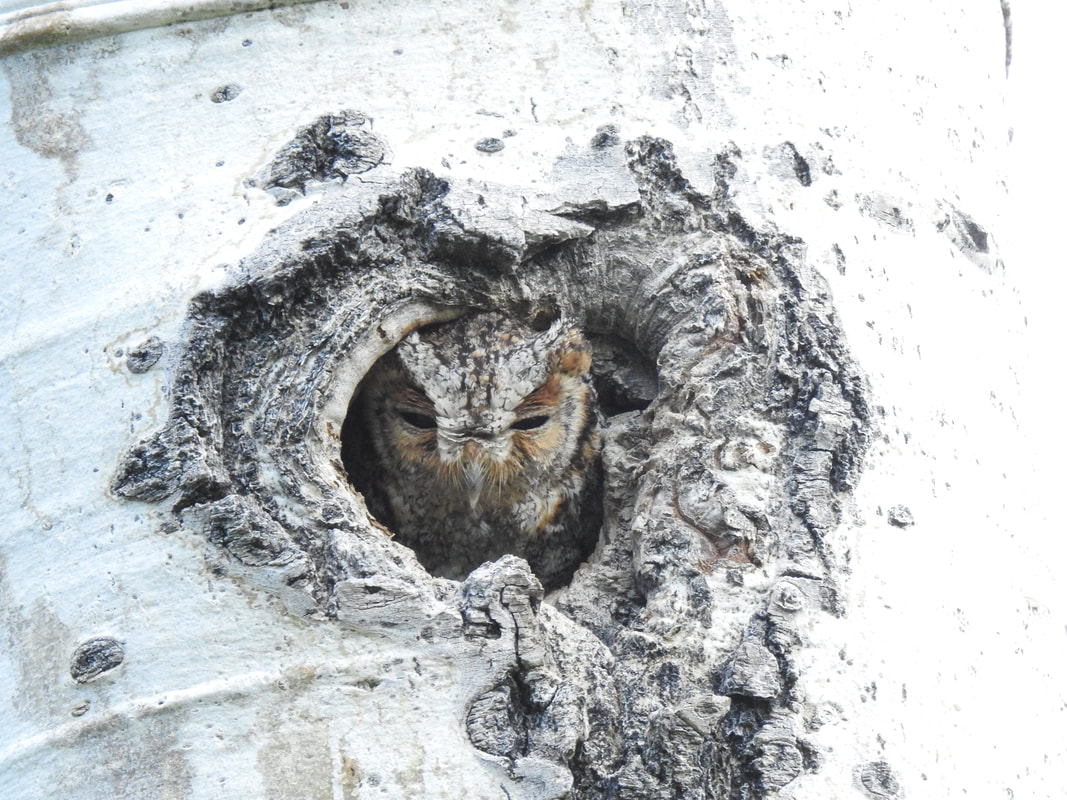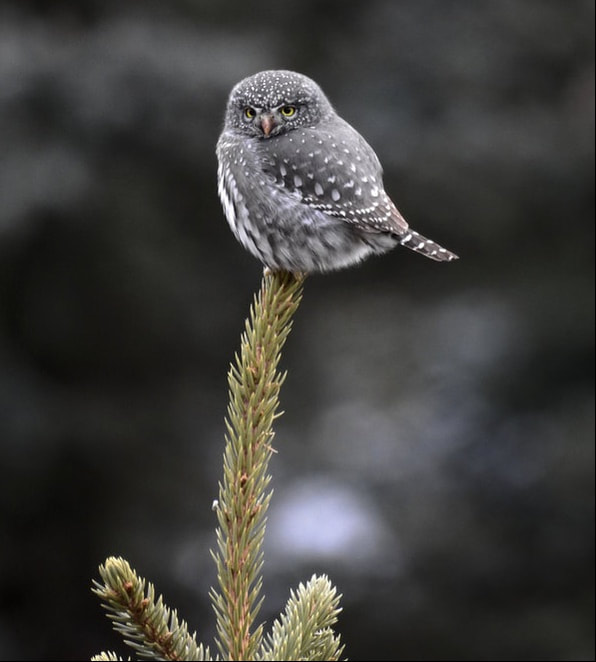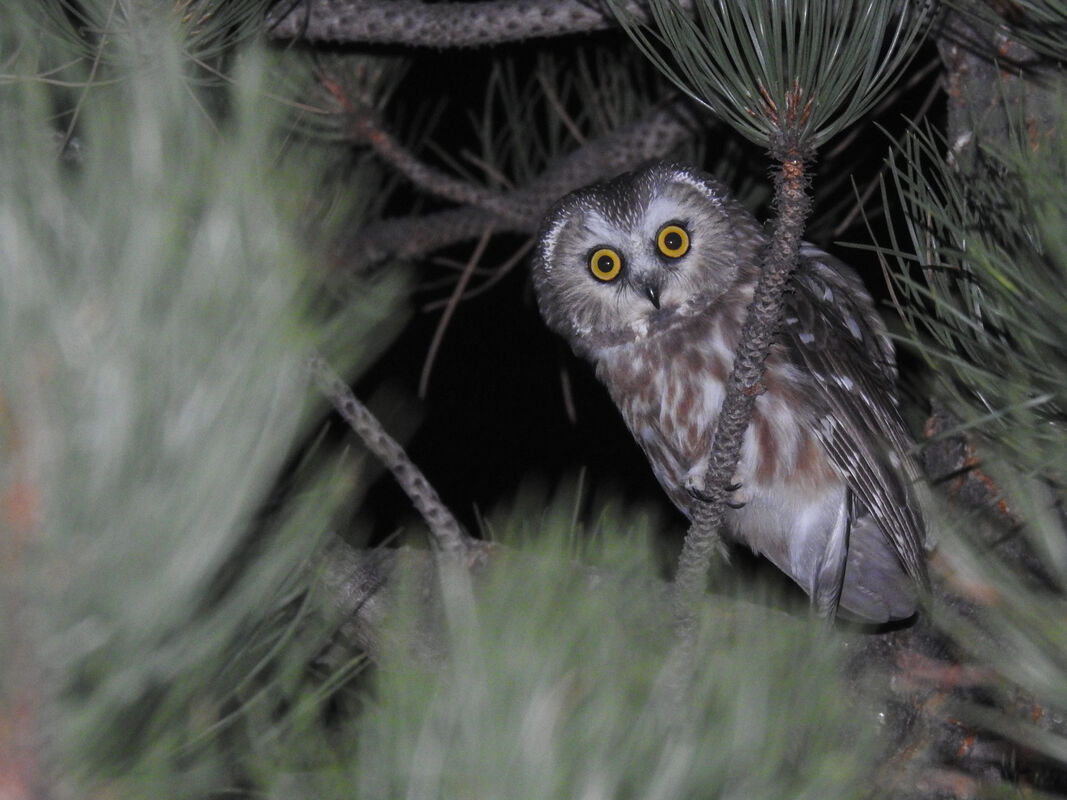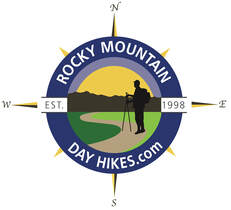|
Notes from the
Trail |
|
by Scott Rashid, Director of Colorado Avian Research and Rehabilitation Institute (CARRI) There are four species of small owls that reside in and around Rocky Mountain National Park (RMNP). The Boreal Owl, Northern Saw-whet Owl, Flammulated Owl and the Northern Pygmy-Owl. All these owls are secondary cavity nesting species, which means that they need to nest in a cavity but cannot create one themselves. Therefore, they need to use an abandoned woodpecker cavity or a nest box that has been provided for them. Apart from the Flammulated Owl, these owls can be found in the area year-round. The Boreal Owl is often found in the Boreal Forest above 9000 feet, the Northern Saw-whet can be found in a multitude of habitats form just below tree line to the foothills. The Northern Pygmy-Owl has a bit more preferred habitat, as they prefer a mixed forest type that consists of aspen, fir, spruce, juniper downed logs, small openings within the forests and a water source. The diminutive Flammulated Owls winter in Mexico and nest up here where they feed primarily on insects, including moths, beetles, and crickets. The Boreal Owl feeds upon voles, mice, small birds and large insects. The Northern Saw-whet prefers deer mice but will also take a few voles and occasionally a bird or two. The Northern Pygmy-Owls have a more varied diet and consume voles, chipmunks, small to medium-sized birds, and nestlings. The Northern Flicker, the largest woodpecker in the area and is the bird that constructs the cavity that these owls prefer. Northern Flickers create a cavity that has a roughly three-inch entrance hole and is about a foot deep. That appears to be sufficient for each species to raise their families. Northern Pygmy-Owls and Northern Saw-whet Owls prefer a nest cavity that is close to water. In many cases, these birds will choose a nest that is within a few yards of a water source, which could be a creek, stream or pond. This is because both species often capture creatures as large if not larger than themselves, and often get bloody. Having a water source near their nests affords them the luxury of bathing when dirty. Clean feathers help keep the owls warm and dry. Northern Saw-whet Owls have a territory that is about 400 yards, where the Northern Pygmy-Owl has a territory that is about ¾ of a square mile. The Boreal Owl seems only to defend the nest tree and not a territory. The Flammulated Owl has a rather tiny territory as they feed upon insects that are often much more numerous and easier to capture than small birds and mammals. Male Northern Saw-whet Owls begin soliciting a female in January, and begin nesting in March. Boreal Owls often begin calling for a female in February and being nesting in March or April. The Northern Pygmy-Owl begins courtship in mid-February and start nesting in late April, early May. The Flammulated Owls Begin arriving here in Late April and begin nesting in May or June. All the owls raise between two and seven owlets. If they nest in a natural cavity, they usually raise two to three owlets, because a natural cavity frequently is so small it cannot fit more than two owlets and the adult female. If they use a nest box, which is much larger than the natural cavity, they can raise as many as seven. The young of these owls remain in their cavities for about four weeks before they fledge. After fledging they remain with their parents for about a month before moving out on their own. This movement often occurs in July or August depending upon when they hatched. Each fall, after dark, researchers around the country broadcast the calls of the owls and set up a series of mist nets to capture the owls as they move in their wintering grounds. We operate one of those research stations in RMNP where we capture and band both Northern Saw-whet Owls and Boreal Owls. The reason for banding the birds is to gain insight into where the birds move to and how long they live. Due to the birds being nomadic, we have only had three Northern Saw-whet Owls recaptured. One Northern Saw-whet Owl was banded in Pinewood Springs, about 15 miles east of Estes Park and recaptured in Estes Park two years later. Another bird was recaptured where it was banded in Estes and the third was banded in Estes and recaptured in Eastern Pennsylvania. Except for the Flammulated Owls, the owls are vocalizing now and can be heard calling for mates. The Northern Pygmy-Owl is active during the day, and the others are active after dark. Hopefully you can get out this spring and hear/see one or more of these wonderful creatures.
0 Comments
Leave a Reply. |
"The wild requires that we learn the terrain, nod to all the plants and animals and birds, ford the streams and cross the ridges, and tell a good story when we get back home." ~ Gary Snyder
Categories
All
“Hiking -I don’t like either the word or the thing. People ought to saunter in the mountains - not hike! Do you know the origin of the word ‘saunter?’ It’s a beautiful word. Away back in the Middle Ages people used to go on pilgrimages to the Holy Land, and when people in the villages through which they passed asked where they were going, they would reply, A la sainte terre,’ ‘To the Holy Land.’ And so they became known as sainte-terre-ers or saunterers. Now these mountains are our Holy Land, and we ought to saunter through them reverently, not ‘hike’ through them.” ~ John Muir |
© Copyright 2025 Barefoot Publications, All Rights Reserved







